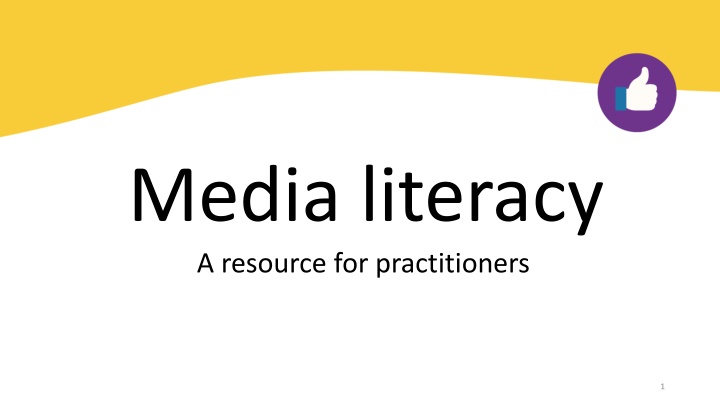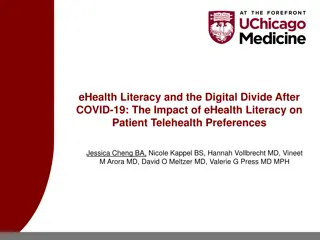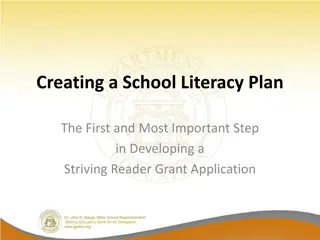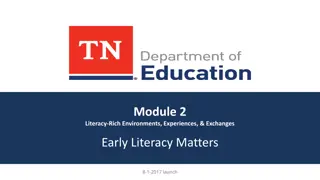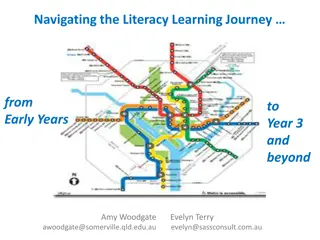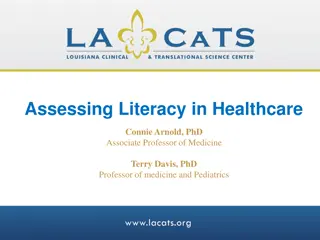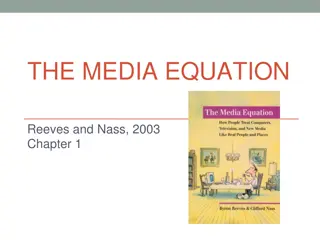Media literacy A resource for practitioners
Explore the concept of media literacy, differentiate between misinformation and disinformation, and learn how to spot false information online. Discover the impact of misinformation, the role of digital media in our lives, and ways to stay safe in the digital world. Enhance your understanding of your digital footprint and develop healthy online behaviors.
Download Presentation

Please find below an Image/Link to download the presentation.
The content on the website is provided AS IS for your information and personal use only. It may not be sold, licensed, or shared on other websites without obtaining consent from the author.If you encounter any issues during the download, it is possible that the publisher has removed the file from their server.
You are allowed to download the files provided on this website for personal or commercial use, subject to the condition that they are used lawfully. All files are the property of their respective owners.
The content on the website is provided AS IS for your information and personal use only. It may not be sold, licensed, or shared on other websites without obtaining consent from the author.
E N D
Presentation Transcript
Media literacy A resource for practitioners 1
Index Learning outcomes What does media literacy mean to you? What is misinformation? What is disinformation? Deepfake technology What is malinformation? Harm caused by misinformation Misinformation can be funny Staying safe online Social media and your digital footprint 3 4 5 9 13 15 18 27 30 32 2
Learning outcomes This resource will help you understand the term media literacy and why it is important. 1. Understand the different forms media literacy can take. 2. Understand the difference between misinformation, disinformation and malinformation. 3. Understand that they have a digital footprint (a record of ALL your interactions online) and that this information can be searched, copied and passed on. 4. Be able to discuss the benefits and risks of presenting themselves in different ways online. 5. Reflect on the role of digital media in their lives and habits. 6. Demonstrate healthy online behaviours and identify unacceptable behaviour. 3
What does media literacy mean to you? Discuss in your groups. 4
What is Mis information? 5
Lets look at the definition of Misinformation Misinformation can mean a lot of different things. It usually refers to false or inaccurate information. It can also include claims that are true but misleading in some way. It can take the form of posts on social media, images and videos, news stories, or claims from celebrities or people in positions of power. People often share misinformation inadvertently, without realising that it is false, this can include fake news . 6
Misinformation can also be spread in order to: 1. Support the views of the creator. 2. To make someone look bad/good. 3. To deliberately spread untruths. How can we spot if someone is spreading misinformation? Can a gorilla really knit?! 7
What is Dis information? 8
Disinformation is spread on purpose Disinformation is a form of misinformation that is knowingly (intentionally) spread. Whilst misinformation can be spread unintentionally. The key difference to remember is intent . Did the person intend to spread false information? 9
Why do countries at war spread disinformation? Disinformation can include manipulated narrative or facts, including propaganda. Countries for example often want to spread disinformation to their rival nations. Can you think of examples of disinformation spread intentionally in the news? 10
Which of these statements below are examples of disinformation? Coronavirus can be treated by bathing in seawater Ghost of Kyiv hero fighter pilot destroys six Russian planes Superstar Tom Cruise endorses bubblegum lollipop on TikTok Activist Greta Thunberg paid by green energy giants to lie about climate change UK General Election to be held over 2 days 11
Deepfake or real? Deepfake technology uses someone else s identity in a video to trick the viewer. You can swap someone s face for a celebrity s for instance. As technology becomes more advanced, it s harder to recognize if a deepfake video is real or not. Watch this TikTok video of Tom Cruise talking about bubblegum lollipops. Could you tell it was fake? 13
What is Mal information? 14
Remember Mal=Malicious Malinformation is also a type of misinformation. It s intentional and is usually used to get information from you. For example, people can deceive you into revealing sensitive information so they can steal money from you online which is called phishing . This can happen via email, text or social media. 15
Malinformation can be real information Malinformation can also be real information that s spread deliberately, and with malice, such as doxing . Doxing is when someone reveals your personal, private information online without your consent, such as your home address. 16
Types of harm created by misinformation 1. Risk to life and health (e.g. vaccine misinformation) 2. Risk to finances (e.g. scams) 3. Risk to reputation (e.g. defamation, making someone look bad) 4. Risk to democracy (e.g. voting misinformation) 5. Risk to engagement (e.g. political figures spinning stories, creating apathy) 18
Misinformation can manipulate your emotions Misinformation can be effective because it make you feel strongly about something. Content that makes you laugh, cry or feel outraged could make you act impulsively and share something you shouldn t. Propaganda, usually found in politics can also be used to promote one side of an argument and is not necessarily true. Throughout history, propaganda has been used to play to people's emotions to encourage them to take specific actions. It can be very dangerous. 19
Create your own tweet showing misinformation Here s an example: 20
How can we help stop the spread of misinformation? Look at this graphic. How could this misinformation affect us? Is it dangerous? Why? Discuss. Graphic: Ofcom 21
Watch this video 22
North Sea Oil company chief executive claims that Climate change is fake Why do you think the chief executive would make this claim in the video, that climate change is fake? Who do you think would benefit from these claims? 23
Ask yourself the following questions Who created this information? Why did they create this? Does it sound true? Is the source reliable? Who could you ask for help? Do you think it is true? Why? 24
Headline: Petition reports that climate change is not caused by human activity What is misleading about this headline? Is a petition a valid source? Why not? Remember to look out for misleading headlines. 25
Misinformation can be funny 26
Misinformation can make us laugh Some people create misinformation on purpose because it is funny. You may see it on TV or read it on websites, in magazines or newspapers. This is called satire or parody. Some people believe these stories. Can you think of an example of satire or parody? Find one and discuss it. Is it still believable? 27
Watch this YouTube video Can you work out what kind of misinformation Bart Simpson is spreading in the video? Give reasons for your answer. 28
Staying safe online 29
How do we know if a website is reliable? Type the website name into a search engine and check: Does it have a good or bad reputation? Are the reviews from independent sources? Check the site s security status. You can do this by clicking on the small padlock at the beginning of the address. If the site has spelling mistakes or uses bad grammar, then it may be time to question the reliability of the site. Always remember, that if it sounds or looks too good to be true, then it often is! 30
Social media and your digital footprint 31
Think about how you use social media. What are the benefits? How can it support you? What are the dangers? Make a list and see how the benefits compare to the risks. 32
Think about your digital footprint Remember that a digital footprint is information or data that is left behind when users have been online. Once something is shared or posted online, it can be there forever! Every time you go online you create a trail of information that you have viewed or created. This can have a lasting impact on your reputation, relationships and employment opportunities. 33
Get media savvy Look at the links below for some helpful hints about misinformation and staying safe online: Hwb Keeping safe online Hwb Keeping safe online Misinformation Hwb Misinformation training for practitioners 34
